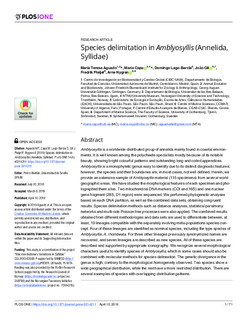| dc.contributor.author | Aguado, M.T. | |
| dc.contributor.author | Capa, Maria | |
| dc.contributor.author | Lago-Barcia, D | |
| dc.contributor.author | Gil, João | |
| dc.contributor.author | Pleijel, F | |
| dc.contributor.author | Nygren, Arne | |
| dc.date.accessioned | 2019-09-24T05:59:49Z | |
| dc.date.available | 2019-09-24T05:59:49Z | |
| dc.date.created | 2019-09-20T12:19:19Z | |
| dc.date.issued | 2019 | |
| dc.identifier.citation | PLOS ONE. 2019, 14 (4), e0214211-?. | nb_NO |
| dc.identifier.issn | 1932-6203 | |
| dc.identifier.uri | http://hdl.handle.net/11250/2618316 | |
| dc.description.abstract | Amblyosyllis is a worldwide distributed group of annelids mainly found in coastal environments. It is well known among the polychaete specialists mostly because of its notable beauty, showing bright colourful patterns and outstanding long and coiled appendices. Amblyosyllis is a monophyletic genus easy to identify due to its distinct diagnostic features; however, the species and their boundaries are, in most cases, not well defined. Herein, we provide an extensive sample of Amblyosyllis material (115 specimens) from several world geographic areas. We have studied the morphological features of each specimen and photographed them alive. Two mitochondrial DNA markers (COI and 16S) and one nuclear gene fragment (28S, D1 region) were sequenced. We performed phylogenetic analyses based on each DNA partition, as well as the combined data sets, obtaining congruent results. Species delimitation methods such as distance analyses, statistical parsimony networks and multi-rate Poisson tree processes were also applied. The combined results obtained from different methodologies and data sets are used to differentiate between, at least, 19 lineages compatible with the separately evolving meta-populations species concept. Four of these lineages are identified as nominal species, including the type species of Amblyosyllis, A. rhombeata. For three other lineages previously synonymized names are recovered, and seven lineages are described as new species. All of these species are described and supported by appropriate iconography. We recognize several morphological characters useful to identify species of Amblyosyllis, which in some cases should also be combined with molecular methods for species delineation. The genetic divergence in the genus is high, contrary to the morphological homogeneity observed. Two species show a wide geographical distribution, while the rest have a more restricted distribution. There are several examples of species with overlapping distribution patterns. | nb_NO |
| dc.language.iso | eng | nb_NO |
| dc.publisher | Public Library of Science (PLOS) | nb_NO |
| dc.rights | Navngivelse 4.0 Internasjonal | * |
| dc.rights.uri | http://creativecommons.org/licenses/by/4.0/deed.no | * |
| dc.title | Species delimitation in Amblyosyllis (Annelida, Syllidae) | nb_NO |
| dc.type | Journal article | nb_NO |
| dc.type | Peer reviewed | nb_NO |
| dc.description.version | publishedVersion | nb_NO |
| dc.source.pagenumber | e0214211-? | nb_NO |
| dc.source.volume | 14 | nb_NO |
| dc.source.journal | PLOS ONE | nb_NO |
| dc.source.issue | 4 | nb_NO |
| dc.identifier.doi | 10.1371/journal.pone.0214211 | |
| dc.identifier.cristin | 1727174 | |
| dc.description.localcode | Copyright: © 2019 Aguado et al. This is an open access article distributed under the terms of the Creative Commons Attribution License, which permits unrestricted use, distribution, and reproduction in any medium, provided the original author and source are credited. | nb_NO |
| cristin.unitcode | 194,31,10,0 | |
| cristin.unitname | Institutt for naturhistorie | |
| cristin.ispublished | true | |
| cristin.fulltext | original | |
| cristin.qualitycode | 1 | |

